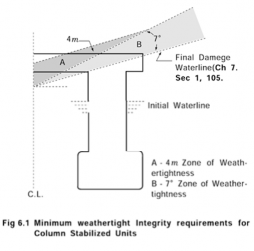

< Previous | Contents | Next >
Section 2 Closing Appliances
201. General
The construction and closing appliances of openings through which the sea water is likely to flow
in are to be in accordance with the requirements in Pt 4, Ch 3,
Sec 3 of Rules for the
![]()
Classification of Steel Ships and International Convention on Load Lines, except that those which are provided in column-stabilized units, which are not located within areas of calculated im- mersion and for which special considerations are given, are to be at the discretion of the Society.
202. General requirements related to watertight integrity
1. External openings, such as air pipes (regardless of closing appliances), ventilators, ventilation intakes and outlets, non-watertight hatches and weathertight doors, which are used during operation of the unit while afloat, are not to submerge when the unit is inclined to the first intercept of the right- ing moment and wind heeling moment curves in any intact or damaged condition. Openings, such as side scuttles of the non-opening type, manholes and small hatches, which are fitted with appli- ances to ensure watertight integrity, may be submerged(Such openings are not allowed to be fitted in the column of stabilized units ). Such openings are not to be regarded as emergency exits. Where flooding of chain lockers or other buoyant volumes may occur, the openings to these spaces should be considered as downflooding points.
2. External openings fitted with appliances to ensure watertight integrity, which are kept permanently closed while afloat, are to comply with the requirements of paragraph 4.
3. Internal openings fitted with appliances to ensure watertight integrity are to comply with the follow- ing:
(1) Doors and hatch covers which are used during the operation of the unit while afloat should be remotely controlled from the central ballast control station and should also be operable locally from each side. Open/shut indicators should be provided at the control station. In addition, re- motely operated doors provided to ensure the watertight integrity of internal openings which are used while at sea are to be sliding watertight doors with audible alarm. The power, control and indicators are to be operable in the event of main power failure. Particular attention is to be paid to minimizing the effect of control system failure. Each power-operated sliding watertight door shall be provided with an individual hand-operated mechanism. It shall be possible to open and close the door by hand at the door itself from both sides.
(2) Doors or hatch covers in self-elevating units, or doors placed above the deepest load line draft in column-stabilized and surface units, which are normally closed while the unit is afloat may be of the quick acting type and should be provided with an alarm system (e.g., light signals) showing personnel both locally and at the central ballast control station whether the doors or hatch covers in question are open or closed. A notice should be affixed to each such door or hatch cover stating that it is not to be left open while the unit is afloat.
(3) The closing appliances are to have strength, packing and means for securing which are suffi- cient to maintain watertightness under the design water pressure of the watertight boundary un-
der consideration.
4. Internal openings fitted with appliances to ensure watertight integrity, which are to be kept perma- nently closed while afloat, are to comply with the following:
(1) A signboard to the effect that the opening is always to be kept closed while afloat is to be fit- ted on the closing appliance in question.
(2) Opening and closing of such closure devices should be noted in the unit’s logbook, or equivalent.
(3) Manholes fitted with bolted covers need not be dealt with as under (1).
(4) The closing appliances are to have strength, packing and means for securing which are suffi- cient to maintain watertightness under the design water pressure of the watertight boundary un-
der consideration.
203. General requirements related to weathertight integrity
1. Any opening, such as an air pipe, ventilator, ventilation intake or outlet, non-watertight sidescuttle, small hatch, door, etc., having its lower edge submerged below a waterline associated with the zones indicate in (1) or (2) below, is to be fitted with a weathertight closing appliance to ensure the weathertight integrity, when:
(1) a unit is inclined to the range between the first intercept of the right moment curve and the wind heeling moment curve and the angle necessary to comply with the requirements of Ch 7,
201. during the intact condition of the unit while afloat; and
![]()
(2) a column-stabilized unit is inclined to the range:
(A) necessary to comply with the requirements of Ch 7, 105. 1 (3) and with a zone measured
4.0 m perpendicularly above the final damaged waterline per Ch 7, 105. 1 (1) referred to
Fig 6.1, and
(B) necessary to comply with the requirements of Ch 7, 105. 2 (3).
2. External openings fitted with appliances to ensure weathertight integrity, which are kept permanently closed while afloat, are to comply with the requirements of 202. 4 (1) and (2).

3. External openings fitted with appliances to ensure weathertight integrity, which are secured while afloat are to comply with the requirements of 202. 3 (1) and (2). ![]()
![]()